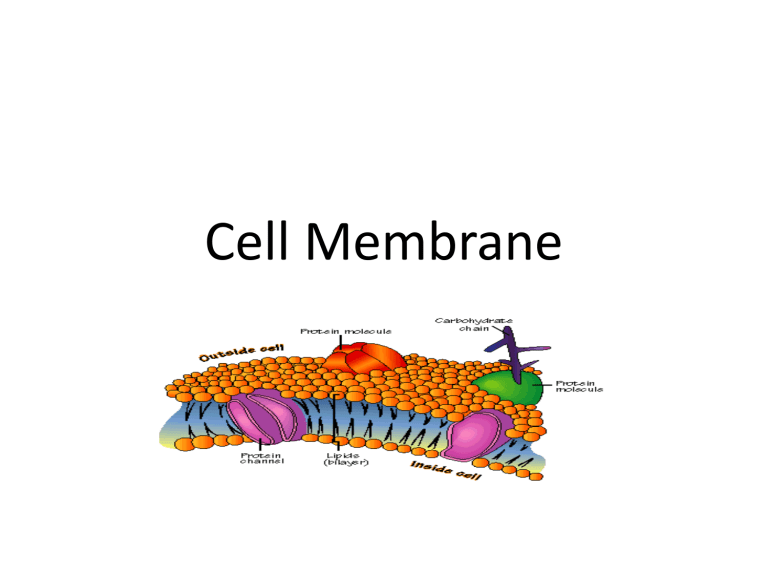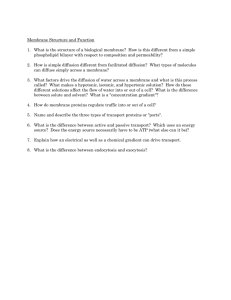
Cell Membrane
I. Cell Membrane
• Separates the cell from the environment
• Keeps internal conditions constant(balanced)
• Controls movement of material in and out the cell
– Selectively Permeable- only allows certain materials to move in and out
Structure of Cell Membrane
• Fluid-Mosaic Model
– Two layered structure composed of
• Phospholipid Bilayer
– Phosphate Head that is hydrophilic
– Fatty Acid Tail that is hydrophobic
• Proteins
– Can be in inner layer
» Intrinsic Protein
– Can be in outer layer
» Extrinsic Protein
Structure of Cell Membrane
• Carbohydrates
– Branch out from external surface of the membrane (markers)
II. Diffusion, Osmosis and Active
Transport
• Material needs to be able to move in and out of the cell
– Some materials move in and out easier than others
– Movement is dependent on the size of the molecule, polarity, or if they are fat soluble
Diffusion
• Movement of molecules from an area of high concentration to an area of low concentration
– The difference in concentration between two areas is called the concentration gradient
• Diffusion will only occur if a gradient exists
• Eventually it will reach an equilibrium
Diffusion
Active Transport
Active Transport
C. Passive Transport- describes how certain things are allowed through the cell membrane because of its selective permeability.
D. Facilitated Diffusion- is diffusion through the cell membrane using the proteins that are located in-between the phospholipid cell membrane.
E. Osmosis – is the diffusion of water (from high concentration to low concentration).
IV. Concentrations in a Cell
A. Solutes – are particles dissolved in something.
B. Solvents- is the solution the particles are usually dissolved in. (Water is the “ most popular ” )
C. Tonicity- describes how much solute there is in a solvent.
V.Types of Tonicity
A. Hypertonic- high concentration of solute in the solvent.
B. Hypotonic- low concentration of solute in solvent.
C. Isotonic- balanced concentration
VII. Other Cell Membrane Functions
A. CELL MARKERS- help recognize foreign substances that enter the body.
B. RECEPTORS- help regulate body control by recognizing and acting on released hormones.
VII. How CELL MARKERS work
A. The presence and distribution of proteins within the cell membrane are unique to individuals.
B. The patterns and proteins that are present act like our cells ’ own unique identification card.
C. Things that enter the body and do not have the proper ANTIGENS (or cell markers) will be attacked by the immune system and
ANTIBODIES (chemicals the body produces to attack foreign substances.
VIII. How Cell Receptors Work
A. The body communicates with itself using chemical messengers called hormones.
B. Like enzymes, hormones are specialized proteins.
C. Hormones are produced in glands in the body and are transported to their target cells in the bloodstream.
D. Once at a target cell, hormones will attach to a receptor protein on the cell membrane.
E. This is like a “ light switch ” that turns on a particular function in the cell.
IX. Cell Receptors and Activation
A. When a hormone binds to a receptor, it causes the activation of a mechanism inside the cell.
B. Some common hormones that are received include:
Insulin
Thyroxin
Adrenalin



